Stasis: Bone Totem review – Sci-fi horror sequel mostly reaches stunning new heights from the ocean depths

- 3 Comments
When the credits rolled on Stasis, 2015’s now-classic isometric sci-fi horror adventure, there wasn’t much room left for a sequel. Most plot threads were sewn up as tightly as a surgical suture, and Cayne, the free add-on that followed two years later, told a self-contained side story about brand new characters. It was hard to imagine any hypothetical future entry that could feel both organic and necessary, so it’s refreshing to see that Chris and Nicholas Bischoff have decided to take an unexpected and mostly successful tack with Stasis: Bone Totem. This is a bold and self-assured follow-up, surpassing its predecessor in nearly every way that matters; when it stumbles, primarily in its overstuffed final third, it’s largely because its ambitious reach exceeds its grasp.
Bone Totem advances the story of Stasis and Cayne’s far-future setting, but it isn’t a “sequel” in any real sense. A character from the former is mentioned (once) by name, and there are veiled references to the events of the latter, but new players will have little trouble understanding Bone Totem on its own terms. (Familiarity with the previous games—especially Cayne—will add depth, resonance, and context here, but it’s not required.)
Setting itself immediately apart from its predecessors, Bone Totem opens on Earth, as seafaring husband-and-wife salvage team Mac and Charlie O’Bannon discover what seems to be a derelict oil platform in the middle of the ocean. The couple has fallen into dire financial straits following the loss of their daughter, and a find of this size will go a long way toward helping them rebuild their lives. On closer inspection, however, Mac and Charlie discover that the platform is no derrick at all—it’s the very tip of DEEPSEA 15, an undersea elevator built to shuttle technicians down to a pelagic research lab called the MULE (for Mobile Undersea Living Environment).
The O’Bannons can tell immediately that something’s not right. It isn’t just that there are dead bodies on the platform—the salvagers are inured to such sights, having dealt frequently with the aftermath of nautical accidents—but one of them seems to have been mutilated and posed postmortem. The sight is enough for Mac to suggest abandoning the project altogether, but Charlie convinces him to keep exploring. It’s clear that DEEPSEA 15 has been abandoned for some time, and finishing this expedition empty-handed likely means losing their boat and their livelihood entirely. Along with Moses, their late daughter’s robotic “super-toy” teddy bear—whom Charlie has upgraded with high-powered hacking tools and other programs useful to their salvage enterprise—the O’Bannons enter the dive capsule and descend into the darkness of the sea.
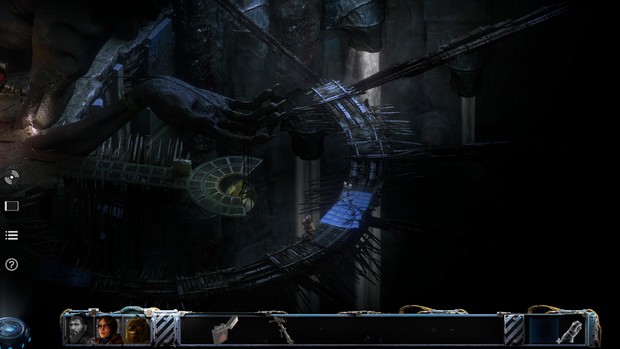
So far, so ominous, but things deteriorate quickly: shortly after touchdown, an accident destroys the capsule and strands the protagonists miles below the surface. They’re initially sanguine about their chances of escape—surely a deep-sea facility was designed with redundant safety systems—but unbeknownst to them, they have much, much more to worry about. That’s because the MULE was a project of the Cayne Corporation, a massive biotech company that players of Stasis and Cayne will remember well.
As detailed in those earlier titles, Cayne Corporation has achieved all of its medical advances by conducting horrifically unethical experiments on kidnapped human test subjects. The O’Bannons, of course, don’t know about this: Cayne conducts its most unsavory research in deep space, where no one will find out. In fact, following the events of Cayne, the company has grown so vast and influential that veneration of its founder has supplanted many of the world’s religions to become Earth’s de facto faith. Mac holds Cayne in especial reverence: thanks to a brain implant that preserves a person’s mind after death and uploads it to a digital paradise called the Nexus, they offer him the possibility of one day reuniting with his daughter.
Exploring the MULE in search of an exit gives the O’Bannons a crash course in how Cayne truly does business. The facility is littered with corpses, both of test subjects and employees—many of them deformed, mutilated or mysteriously changed. Notes scattered throughout reveal that Cayne was conducting research into something they’d discovered deep under the sea, and whatever it was, it produced staggering mental and physiological alterations in test subjects. The company’s characteristic disregard for safety and employee welfare led inexorably to the grisly calamity at whose center the O’Bannons now find themselves; worse, it’s clear they aren’t alone.
It’s obvious from the outset how much work went into developing Bone Totem’s story, setting, and characters, and they remain its greatest strength throughout. The central mystery—what exactly happened in the MULE, and what was Cayne studying there?—is teased out expertly using PDAs and research notes belonging to departed (or, more often, dearly departed) employees, so that each new room you access feels like a small piece of a puzzle you’re assembling into a complete picture.
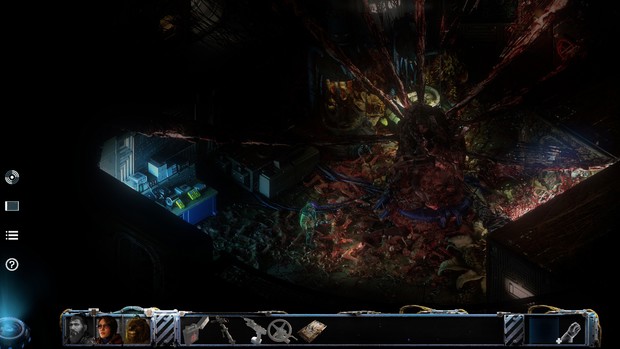
Despite the initial similarities to the first Stasis—a derelict, gore-strewn research facility patrolled by unseen horrors—Bone Totem never feels remotely like a retread. For the majority of its fourteen-hour runtime, the story remains fresh and unexpected; moving from one horrifying set piece to another yields novel and varied scares and fresh science-fictional concepts. You’ll come across plenty of intriguing side stories as you read through the technicians’ PDAs, which are excellently and concisely told. There are complete and satisfying arcs here for people you never meet, and whose impact may be confined to a single room.
Since nearly everyone in the MULE is either dead, vanished or worse, Mac, Charlie and Moses spend much of the game talking amongst themselves. Various circumstances mean they wind up separated across different parts of the facility—all three are playable, and you can switch between them by selecting their portraits—but they can speak remotely using audiovisual implants. These also let them see and hear through one another’s eyes and ears, so regardless of actual distance they never feel far apart. They do a lot of talking as a result, and since you’ll spend most of your time with no one else for company, it’s no stretch to say that the game’s success or failure rests on their collective shoulders.
Thankfully, Bone Totem has some of the strongest and most vividly realized protagonists in recent adventure gaming history. Their personalities, values and long history together are apparent in every conversation, and all three have distinct ways of talking and expressing themselves, to the point that each has distinct hover-text when examining inventory items. Each speaks differently depending on who they’re talking to, so it’s always clear who’s being addressed. Mac speaks to Charlie with a mix of tenderness, concern, and playful banter, for instance, while he’s usually short and surly with Moses, whom he treats as little more than an inanimate object.
Actors Brian Grey and Michelle Campbell bring Mac and Charlie to life with stunningly versatile vocal deliveries; it’s hard to imagine the story working as well as it does with anyone else in the central roles. I can’t recall a single sour note in either performance, which is especially impressive considering how much dialogue they have. Equally effective is Danny Doyle as the toy bear Moses, who comes to serve as the game’s unexpected heart.
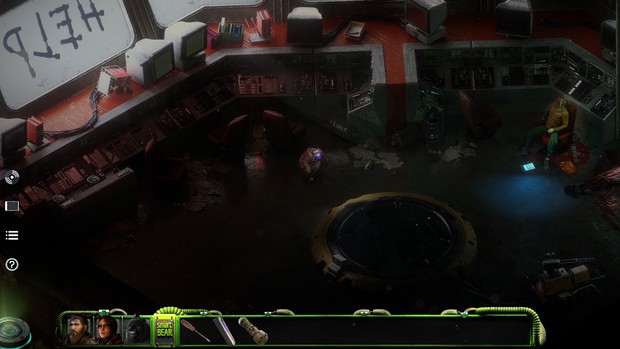
Perhaps more than anything else, Moses’s character needed to work for Bone Totem to succeed. As written and visualized, there was no guarantee that he would: he’s a sentient, robotic, toddler-sized teddy bear with an uncomfortably human face, and there’s no way to put it except that he’s extremely unsettling to look at in close-up. (Picture the offspring of an Ewok and Dreamfall’s Wonkers the Watilla and you’ll have an idea of what I mean.) This is, of course, by design—for reasons that become apparent in-game, it’s crucial that players feel off-balance around him—but it saddles his voice actor with more heavy lifting to ensure you’ll want to spend your time with him.
Thankfully, Doyle threads the needle masterfully. In the wrong hands Moses might have felt unbearably creepy—or, with his childlike personality, cloyingly saccharine—but Doyle manages to imbue him simultaneously with the robotic artificiality that befits his nature and the warm, guileless authenticity necessary to overcome his unpleasant appearance. It’s a complex, emotionally layered performance, all for a character who can’t modulate his voice to match his feelings, and Moses feels destined for the upper echelons of the adventure game sidekick pantheon. (I’ll take him over Joey the robot any day.)
Still, this is a horror game, and no amount of dialogue or characterization could make up for it if the developers skimped on the scary stuff. Thankfully that isn’t a problem; Bone Totem is a very disturbing game in both presentation and subject matter, and there’s a veritable feast here for anyone who wants a good hard shudder. Even when they’re not getting their employees killed, Cayne is a messy company: you’ll walk through rooms full of disconcertingly organic technology, pass down endless corridors of mutilated and decaying corpses, and wade through acres of stomach-churningly open experiments. Discarded PDAs contain sharp, shocking vignettes that could easily stand on their own outside the context of the game. And as to the visuals…well.
The original Stasis was rich in atmosphere, and the glimpses it gave of its horrors were as shocking as they had to be, but Bone Totem elevates the series’ art design to new and rarefied heights. The first game, though acclaimed, was limited by its debut-indie budget; this one blows so far past it that it’s almost hard to believe. Environments, models, character portraits and cutscenes are all gorgeous to look at. If I didn’t know The Brotherhood was primarily a two-person development team, I’d have assumed there were legions of artists laboring over the game’s every visual detail. Slick stone glistens; flesh pulsates; and colored lighting casts foreboding, dynamic shadows. Accompanying it all, Mark Morgan’s supremely creepy soundtrack creates an atmosphere of ever-present menace, heightened by Moses’s unsettling tendency to whistle childish nursery songs when he’s nervous.
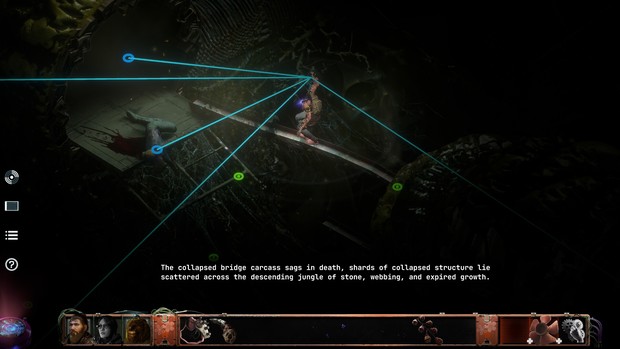
If there’s one complaint in the visual realm, it’s simply that the MULE can be too damn dark. Atmospherically, of course, it’s appropriate—anything could lurk in all those shadows—but there are times when it’s difficult to actually see what the characters are reacting to. I played around with the lighting in the visual menu, but even on the brightest setting I had trouble making out some details. The darkness, then, appears to be intentional, but I found it blunted the scares somewhat to hear Mac and Charlie ask one another, “Are you seeing what I’m seeing?” only to want to answer “No! I’m not!”
This would be more of a problem if it made it harder to navigate or pick up visual cues, but Bone Totem has one of the most gracefully integrated interfaces I’ve come across. The controls are simple point-and-click, with your inventory at the bottom of the screen alongside your row of character portraits; left-clicking in the environment moves your character to that spot. What sets Bone Totem apart, though, is its “Ping” feature—basically a sophisticated hotspot highlighter that draws lines from your character to every on-screen point of interest.
Most of these appear as green circles over a visual detail, where hovering your cursor summons up a bit of descriptive text to give a sense of what your character sees. Blue circles denote interaction points: screen exits, PDAs, computer terminals, items to pick up, and close-ups that allow for more direct examination. (Pinging in close-up points out available hotspots as well; you can only use your inventory in these screens.) It’s an elegant system for navigating what could otherwise have been intimidatingly busy (or impenetrably dark) environments, and it makes it easy to take in Bone Totem’s full breadth without missing anything.
Naturally, as a classically inspired point-and-click adventure—albeit one viewed top-down from a zoomable isometric perspective—Bone Totem is full of problems to solve, the majority of which are creative and challenging. Inventory puzzles abound, and come with the added twist that Mac and Charlie have their own unique abilities: Mac, as a physically fit veteran with a futuristic prosthetic, can both bend and break certain items and disassemble them into their component parts; engineering whiz Charlie can take two disparate objects and combine them into something new. Using either ability is as simple as dragging items into dedicated slots alongside your character’s inventory and clicking the icon there.
All three characters can trade items at any time, which is managed by dragging an object to the portrait in question. It’s explained that the O’Bannons accomplish this using a “Quantum Storage Device” (QSD), a piece of futuristic technology that works well as a plot device but might as well have “DON’T THINK ABOUT IT TOO HARD” printed on the side.
Some of the best puzzles don’t feature the inventory at all, but rather ask that you piece together information from your environment. Oftentimes your end goal is to operate a machine or manipulate some bit of Cayne’s mad science to your own purpose, and for the most part these sequences feel like challenging treasure hunts for your next vital clue. There are, however, a few notable duds; I solved these only through brute force, from which followed the age-old Snarl of the Adventure Gamer (“Oh come on, how the hell would I have thought of that?”)
About two thirds of the way through, I felt like Bone Totem was shaping up to be a game of the year contender … which was, unfortunately, contingent on the mistaken impression that I was almost finished. The story was approaching what felt like a natural crescendo, a sudden revelation had just cast a new light on everything I thought I’d known, all the pieces seemed to be slotting into place for a grand and satisfying finale—and then the game just kept going. And going. For several more hours.
New environments were introduced outside of the MULE, with whole swathes of plot suddenly tied to what had seemed like background elements; new characters appeared to deliver cumbersome piles of expository dialogue that explained, in great detail, the whys, whats and wherefores of all the tantalizingly obscure horrors whose mysterious secrets the game had previously only teased. Conversations began to feel repetitive, restating well-established character beats and retreading thematic points that had been driven home hours earlier. The nightmarish Cayne Corporation, such an effective and frightening antagonist both here and in the previous games, all but vanished from the story, displaced by a new external threat to which neither I nor the O’Bannons had any real connection.
The change was so abrupt and so complete that I began to feel like I’d been thrown into a different—and much less interesting—game. The new threat feels cobbled together from familiar and overused horror templates, adding little to the story except to change it from a personal one, in which the O’Bannons must struggle to escape and rebuild their lives, into one that would apply to any human being opposed to unleashing the apocalypse. Most disappointingly, their introduction causes the game to all but abandon the overarching story the Stasis series has been telling all along—that of the amoral, hypercapitalist Cayne Corporation and the people who live in its terrifying world—in favor of a pulp-action Temple of Doom / H.P. Lovecraft pastiche that bumps up against the uglier aspects of both.
Final Verdict
It’s to Bone Totem’s immense credit that, after all that, I still consider it far more successful than not. The first two thirds are so impressive and so consistently strong that the lackluster ending can’t fully diminish them. When Bone Totem is firing on all cylinders, it’s an inventive, engaging and gorgeously visualized slice of nightmare. It follows up its predecessors in a novel and surprising way, and it provides a satisfying new chapter in the story of the Cayne Corporation. It’s impossible to ignore when it starts running out of gas, and it’s hard for me to imagine a way the climactic material might ever have worked as a conclusion to what came before. Still, Bone Totem is consistently ambitious in its aims, and if the developers can take and build on the parts that succeeded, I’d happily follow them once more into the ominous darkness of the future.
Hot take
Though cracks are visible in its impressive facade by the time the credits roll, Stasis: Bone Totem is a wildly ambitious follow-up that builds effectively on the macabre promise of its predecessors.
Pros
- Superb horror atmosphere with beautifully frightening visuals and an effective soundtrack
- Majority of the story is well-written, with memorable main characters and excellent dialogue
- Astounding vocal performances by the main trio of actors
- Many challenging and well-designed puzzles
- Follows up the overarching story of Stasis and Cayne in an interesting and unexpected way
Cons
- Disappointing final act that feels overstuffed and only incidentally connected to the rest of the game
- Some puzzles are poorly clued and illogical
- Dark, shadowy visual design makes environmental details difficult to see at times
Will played Stasis: Bone Totem on PC using a review code provided by the game's publisher.

- Advertisement
- Help support AGH by advertising with us









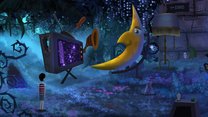
3 Comments
Want to join the discussion? Leave a comment as guest, sign in or register.
Pretty spot on here. While impressed enough to be intrigued about what The Brotherhood do next, they could greatly benefit from story editing/pace and making puzzles less brilliantly annoying.
Reply
Where did this review go? Would love access to it, please! Thank you:)
Reply
Hi, michelleacampbell34. Sorry you can't see the content. We've had a bug that temporarily causes this on occasion, but we thought we had it finally stamped out. Can you try again and let us know if it's still happening? EDIT: Did a quick debug check and our fix does appear to still be working, so perhaps it's a bugged cached post on your browser? If it's still happening, please try refreshing the page or cleaning the site cache from your browser.
Reply
Leave a comment